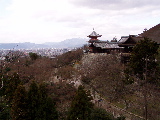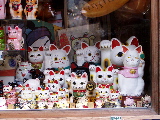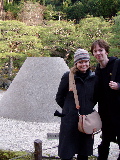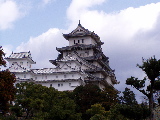 |
|
|
|
New Year in Kyoto  Let's imagine for a moment that time zones do not exist, that every person in every country in the world experienced the dawn of 2003 simultaneously: midnight in New York occurring at the same time as midnight in London and Bangkok and Sydney and Tokyo. And in this unified world, on New Year's Eve, as midnight strikes, people everywhere are drinking and dancing and singing 'Auld Lang Syne' — or at least watching people doing these things on TV. My girlfriend and I, however, are not doing any of this. We are standing in the grounds of a small temple in a residential part of Kyoto, not too far from the city centre but far enough for the neon and traffic to be invisible and inaudible, and we are watching people line up in the gloom to take turns at striking a bell. Each person — man, woman, child, monk — steps onto a podium, grasps a thick rope and pulls it back and forth a couple of times until, with a loud clang that resonates through the chilly air, they make their own contribution to the 108 chimes that greet the New Year. 'You want to ring the bell?' a woman asks, but we step back and tell her we're just watching. We're not Buddhists, so we'd feel as if we were intruding. The tradition in our own Christian country is to spend New Year kissing strangers and being sick (preferably not at the same time), not communicating soberly with the spirits, and we wouldn't want to hijack another country's ritual. Up on the podium, there seems to be some kind of macho contest going on. Who can strike the bell the hardest? I feel sorry for the monk supervising the bonging and hope he has a pair of special holy earplugs. Or maybe he is able to put some kind of zen wall of tranquillity around himself, so that the clang of the bell is no more troublesome than the sound of a leaf fluttering to the ground or one hand clapping. The stars are sharp in the sky, and I watch a man point out the constellations to his son. We head back to our hotel, the chimes still ringing through the air.  Hello Kitties - lucky waving cats This is New Year in Kyoto, the capital of Japan until Tokyo took over. This is my first visit to this city which I always imagined to be the Eastern equivalent of Florence or Bath: a pretty, olde worlde place, well-preserved and stuffed full of museums and tourists traipsing around places of worship. Except, of course, these places of worship are Buddhist and Shinto (the primary religion of Japan), rather than Catholic or C of E, and therefore much more exotic and mystical and mysterious. Giant Buddhas and quiet rock gardens and carp swimming in still, clear water . . . this is my image of Kyoto. Everybody knows Tokyo is garish and deafening, an amusement arcade of a city, but Kyoto is the real, old Japan, isn't it? Well, nearly. In parts — mainly the outer parts — Kyoto is beautiful: full of temples and shrines and the kind of wooden houses we westerners picture when we think of the old Japan — the Japan of geisha and samurai and tea ceremonies. But the downtown area is just like every other city in this country — a crush of high-rise buildings and pachinko parlours and department stores and chain restaurants. The river banks are concrete and the traffic is dense. The train station, a mammoth glass cathedral that lets in the swirling snow and wind, is crowded and chaotic. The people here push and barge just like they do in Tokyo. But the difference is that here, in Kyoto, it's not difficult to escape from the crowds. On our first morning, we walk across a busy road and climb some steps to the Yasaka Shrine, which acts as a gateway between downtown and Gion, famous for being the quarter where geisha used to roam and work. In fact, they still do roam there, but they are a dying breed, an echo of the past that grows ever quieter. We are lucky enough to glimpse a pair of maiko — apprentice geisha — on our way through Gion.  A pair of maiko, apprentice geisha All around us, (Japanese) people grab their cameras and snap away, like birdwatchers spotting a rare specimen. We do it too. The streets are lined with souvenir shops selling every emblem of Japan you can imagine, from fancy fans and exquisitely-packaged sweets to lucky waving cats and Pikachu toys. At the top of the hill stands the Kiyomizu Temple complex, which offers wonderful views of the city and the surrounding hills. Here you can buy lucky charms (for everything from love to traffic safety), and further improve your luck in love by walking with your eyes closed between two large stones, about ten metres apart, which we watch two girls attempt, the first tiptoeing and squealing all the way, applauded by her friends, the other striding confidently. We see another maiko; again, everyone rushes to take her picture. On the second day, we head for Kinkaku-ji, the famous Golden Temple. I'm sure it's spectacular, but can't say for certain as it was covered with a white tarpaulin, undergoing repair. They were still charging 500 yen to look at it though. We turn around and catch a bus to Ryoan-ji Temple. This temple is famous for its rock garden, where 15 stones sit, as stones do, in a bed of neatly-raked gravel. We sit and contemplate the meaning of life for a while — it's a bit like one of those magic eye paintings; you think that if you stare at it long enough it will all suddenly become clear, but I could never get those things to work either. Temples are great places to find vegetarian food (unlike Japan as a whole) and we enjoy a bowl of tofu and vegetables, with rice and green tea, served by a young woman in a traditional Hello Kitty T-shirt. The Silver Pavilion, Ginkaku-ji, isn't covered with a sheet, but it isn't silver, because they never got round to adding the precious metal coating. It's impressive though, and the gardens are lovely, with more grey sand raked and arranged into a perfectly smooth, flat-topped mound.  Beside the Silver Pavilion From the Silver Temple, a canal leads back towards the city centre: this is known as the Philosopher's Walk, after an old university professor. Claire wonders if it would be called the Sorceror's Walk in America. (This is an obscure joke for Harry Potter fans.) This is the peaceful Kyoto we came to see; it's beautiful even in the dead of winter, when the trees are bare and the wind bitter. A kingfisher flashes blue as it stops for a moment on the canal bank then flits away. We take two trips out of Kyoto. The first is to Himeji Castle, a spectacular samurai castle that was rebuilt this century and is in immaculate condition.  Himeji Castle Designed as a fortress, its walls are breached daily now by the barbarian hordes who traipse through its drafty halls with their digital cameras poised. Before entering, you have to take off your shoes and don a pair of slippers. All of the slippers are designed for Japanese feet (in Japan, foreigners have to go to the 'Big Men' shop to find shoes) and therefore my heels touch the ground and the damn slippers nearly fall off every time I go up and down stairs. Ridiculously, this mars my day. But Himeji Castle is fascinating, especially the harakiri quarter, a convenient place to top oneself, with a handy well for washing your decapitated head. Our other trip is to Nara, which is also a former capital of Japan, and famed now for its giant Buddha statue. We walk for miles through the rain until we reach the park, where we walk for miles through the rain until we reach the temple that houses the Buddha. It's really, really big. By this stage of our trip, I was all Buddha-ed out, but the park is home to hundreds of tame deer who wander along the paths and let you stroke them, and every souvenir stall sells little furry models of Bambi. After that, it was time to say farewell to Kyoto. I would like to visit the city during the cherry blossom season or in the autumn, when the trees are red and orange and gold. But I will remember Kyoto for the moments of tranquillity that are so rare in modern Japan, for the chiming of the New Year bells, for the glimpses of tradition and the old world. And on the shinkansen — or bullet train — home, we saw another great, eternal symbol of Nippon: Mount Fuji, dominating the skyline, always the same, new year after new year. For more pictures of Kyoto, Himeji and Nara, visit my .Mac page. |